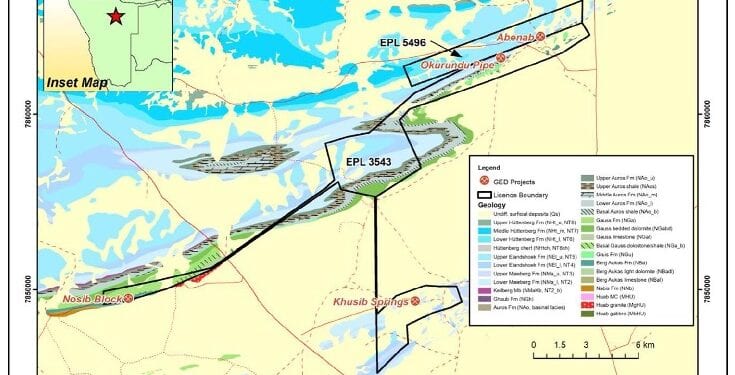Upcoming Drill Programme To Test For Remnant Near Surface Mineralisation
Golden Deeps Limited (ASX:GED) has identified new remnant copper/silver mineralisation on the margins of mined stopes and at depththrough a study conducted on the historic Khusib Springs copper-silver mine in Namibia.
Khusib Springs, located near the town of Grootfontein in Namibia, was a high-grade copper-silver mine from which approximately 300,000t of ore grading 10% Cu, 1.8% Pb and 584g/t Ag was mined.
Previous drill intersections at Khusib Springs include: 4.5m at 35.19% Cu, 3.67% Pb, 2.23% Zn, 2090.91g/t Ag from 30m; and 14.0m at 8.12% Cu, 0.75% Pb, 0.52% Pb, 385.06g/t Ag from 37m
Khusib Springs was mined between 1996 and 2003 when it closed due to the very low copper price at the time and depletion of easily minable high-grade ore. At the beginning of 2003, towards the end of mining, the copper price had fallen to US$1,500 per tonne.
The Khusib Springs mine is considered analogous with the Tsumeb Mine 40km to the northwest that between 1905 and 1996 produced 30Mt of ore grading 4.3% Cu, 10% Pb and 3.5% Zn:
The scope of the Khusib Springs study was to validate the historic drilling data and digitally capture hardcopy mine plans including underground development and stoping plans with a view to assess the potential for further minable ore remaining in the mine.
The data was imported into a 3D mine software package to allow visualisation of the orebody and to assist targeting.
As well as modelling the copper mineralisation, Shango also modelled the combined copper-silver mineralisation because of the high silver grades reported during mining. The average grade of the silver mined at Khusib Springs was 585 g/t, being 18.81 ounces to the tonne.
The study demonstrates that there are remnent zones of copper-silver mineralisation on the margins of the mined stopes as well as at depth. The remnant ore on the margins of the stopes was probably left because of the relatively low copper grade in the light of the then prevailing copper prices.
In addition to the remnant ore in the stopes, a priority zone of remnant copper-silver mineralisation has been identified which is within 100m of the surface. This zone can be easily tested with Reverse Circulation (RC) drilling.
A second priority zone of copper-silver mineralisation has been identified, down plunge of the main orebody. Underground mining revealed that the ore forms a plunging shoot that dips steeply and pinches out at depth.
Deeper wide-spaced drilling was conducted down plunge by the former owner Ongopolo Mining Ltd to intersect possible extensions of the orebody. Some of these holes intersected mineralised zones with elevated copper- silver grades that appear to represent a faulted offset of the orebody. Downhole electromagnetic surveys should be successful at locating off hole conductors that could be tested with drilling.
Golden Deeps says it is excited at the potential for high-grade copper and silver at Khusib Springs. The Company has already requested quotations for an electromagnetic survey at Khusib Springs and is planning a drilling programme to test the remnant mineralisation and the priority targets identified by the study.












